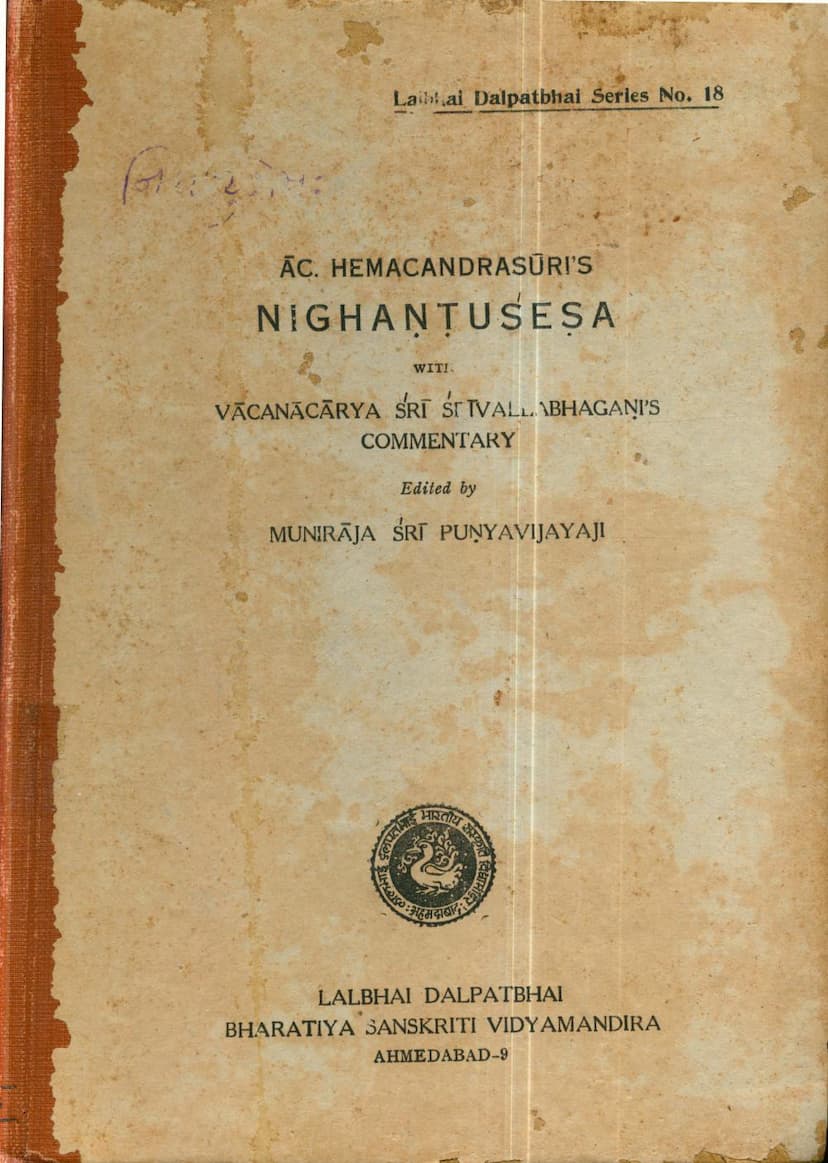Nighantu Shesh
Added to library: September 2, 2025

Summary
Here's a comprehensive summary of the Jain text "Nighantu Shesh" by Punyavijay, based on the provided catalog link and pages:
Book Title: Nighantu Shesh (निघण्टुशेष) Author: Acharya Hemachandrasuri (आचार्यश्रीहेमचन्द्रसूरिविरचितः) Commentary Author: Vacanacharya Sri Srivallabhagani (वाचनाचार्यश्री-श्रीवल्लभगणिविनिर्मितया टीकया समेतः) Editor: Munishri Punyavijayaji (संपादक मुनिराज श्री पुण्यविजयजी) Publisher: Lalbhai Dalpatbhai Bharatiya Sanskriti Vidyamandira, Ahmedabad (प्रकाशक लालभाई दलपतभाई भारतीय संस्कृति विद्यामंदिर अमदावाद-९) Publication Date: June 1968
Overall Purpose and Significance:
"Nighantu Shesh" is a significant Jain text, a lexicon or glossary, composed by the renowned Jain scholar Acharya Hemachandrasuri. This particular edition is notable for being the first publication of the commentary on the work by Sri Srivallabha Upadhyaya, a 17th-century scholar. The text aims to provide names and synonyms for various plants, herbs, trees, and creepers, which is crucial for understanding traditional Indian medicine (Ayurveda) and botany. The editor, Munishri Punyavijayaji, undertook the task of critically editing this rare and previously unpublished text, making it accessible to scholars and researchers.
Key Features and Content:
-
The Original Work (Nighantusesa): Acharya Hemachandrasuri's "Nighantusesa" is a lexicon that lists and classifies various botanical entities. It is divided into six kandas (sections): Vriksha (Trees), Gulma (Shrubs/Bushes), Lata (Creepers), Saka (Herbs/Vegetables), Trna (Grasses), and Dhanya (Grains). This six-fold classification is highlighted as a unique and scientific feature of Hemachandra's work, differing from other nighantus that often use less systematic groupings.
-
The Commentary (Tika): Sri Srivallabhagani's commentary is essential for understanding the nuances of the original text. It provides explanations of the terms, etymologies, and often offers popular names of the plants, many of which are from the Rajasthani language, suggesting the commentator's origin. The commentary also highlights variations in readings found in different manuscripts and sometimes offers critical insights into the accuracy or appropriateness of certain names or descriptions.
-
Editorial Work of Munishri Punyavijayaji: Munishri Punyavijayaji's contribution is substantial. He utilized five manuscripts to create a critical edition. His editorial work includes:
- Critical Editing: Comparing and collating readings from various manuscripts to produce the most accurate text.
- Appendices: The volume includes eight valuable appendices, which greatly enhance its scholarly value. These appendices contain:
- Appendix 1: Variants of the original text of "Nighantusesa."
- Appendix 2: An index of words from the text, including their gender, meaning as explained by the commentator, and the verse number where they appear.
- Appendix 3: An index of popular names mentioned by the commentator, with Sanskrit equivalents. The editor notes that some of these names were suggested by himself.
- Appendix 4: A comparison of popular names found in an older manuscript of "Haimaninghantusesakosa" (150 years prior to the commentator) with those provided by the commentator, demonstrating the antiquity of this tradition.
- Appendix 5: An index of quotations found in the commentary.
- Appendix 6: An alphabetical index of authors mentioned in the commentary.
- Appendix 7: An index of works referred to by the commentator.
- Appendix 8: A comparative study of quotations from the "Dhanvantarininghantu" as they appear in the commentary versus the printed text, highlighting significant variations and potential copyist errors.
-
Content of the Nighantu Shesh: The text enumerates a vast number of plants, providing multiple synonyms for each. It often discusses descriptive names and medicinal properties. The summary highlights how "Nighantu Shesh" often provides more synonyms than earlier works like the "Amarakosa," offering new and sometimes obscure names. The editor points out instances where the commentator's interpretations or readings differ from the manuscripts or other established texts, offering a scholarly analysis of these discrepancies. The popular names of plants are also emphasized as being crucial for students of Ayurveda and Botany.
-
Etymology and Context of "Nighantu": The introduction delves into the etymology of the term "nighantu," tracing it back to "nigama" and explaining its meaning as a lexicon that reveals hidden meanings of words, particularly those related to the plant kingdom. It also discusses the evolution of the term from "nighantu" to "sangraha" and then to "kosa" in later literature. The introduction also contextualizes "Nighantu Shesh" within the history of Indian lexicography, mentioning other important nighantus like the "Dhanvantarininghantu," "Madanapala Nighantu," and "Rajanighantu."
-
Challenges and Observations: The editor notes that many nighantus and their commentaries contain corrupt readings and jumbled terms, possibly due to copyist errors or the authors' attempts to display scholarship without direct observation of the plants. He emphasizes the need for critical study and the retention of scientifically accurate names.
In essence, "Nighantu Shesh" is a meticulously edited and commented Jain lexicon of botanical terms, compiled by Acharya Hemachandrasuri, with a significant commentary by Sri Srivallabhagani. The publication of this work, along with its comprehensive appendices, by Munishri Punyavijayaji, has made a valuable contribution to the study of Indian plant nomenclature, lexicography, and the intersection of Jainism with traditional knowledge systems.